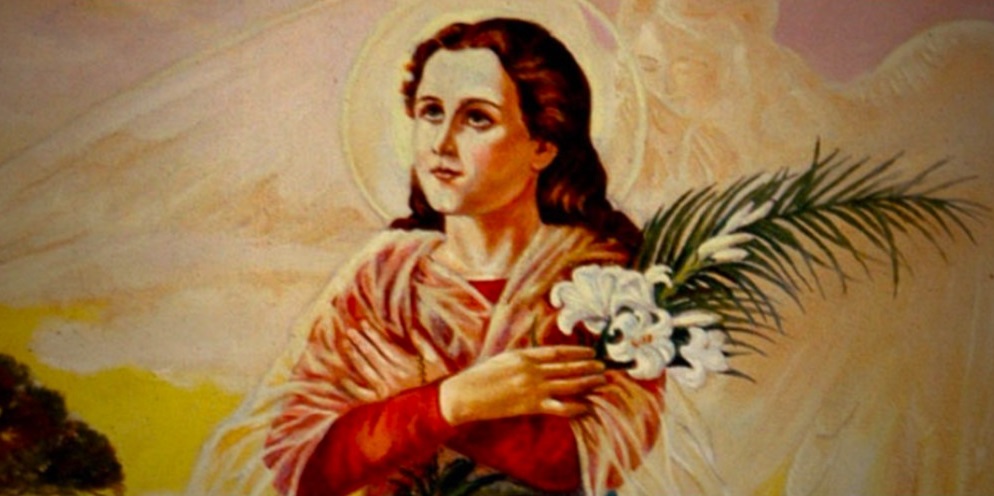YAKIMA (WA)
Horowitz Law [Fort Lauderdale FL]
December 23, 2023
[Image above: St. Maria Goretti. See also Yakima Diocese monument in Calvary Cemetery criticized by clergy sex abuse victim advocates, by Joel Donofrio, Yakima Herald, December 17, 2023, previously blogged in Abuse Tracker.
In an uncanny turn of events, Catholic officials throughout the United States appear embroiled in redefining norms surrounding the grisly subject of abuse – intentionally or unintentionally, it seems – and thereby sending not one but three distressing messages. Let’s break it down:
3 Powerful Yet Troubling Messages About Abuse
- Message to Vulnerable Youngsters: Some might interpret these actions, sadly, as follows, “If you fall prey to a predator but manage to fight them off, pardon their transgressions, and your family tiles over the cracks too; we honor your courage.”
- Message to Wounded Survivors: The narrative morphs, twisting the knife of past trauma even deeper. “The abuser in your story doesn’t matter. All that matters is that you end up forgiving them.”
- Message to Sex Offenders: And the darkest of interpretations – “You can make an attempt to violate a minor, but as long as you seek forgiveness after serving time, we’ll invite you to join us. Heck, you might walk the path to Catholic clergy riches.”
Sounds like a trope from a dystopian society, right? But it’s closer to reality than you think.
Maria Goretti: This Is Her Story
You might ask, how does the church get away with this? The answer lies within the story being propagated. The story of a young girl named Maria Goretti, who is revered as a saint, with her story whispered like a sacred mantra throughout the corners of the Catholic community.
Maria’s narrative made headlines recently when a Washington bishop faced backlash for dedicating a memorial to Goretti in a cemetery – an act that came across as far-fetched to many. Goretti, who hailed from a Catholic, poverty-stricken family, was reportedly eleven when she declined the advances of an older farmhand in her Italian hamlet. According to Catholic teachings, she screamed and wrestled with her aggressor. However, when he resorted to strangling her, she proclaimed she’d prefer death rather than surrender. The atrocities didn’t end there – he proceeded to stab her fourteen times. Three dire days later, on her hospital bed, she breathed her last, having reportedly forgiven her assailant.
Forgiveness and a Path to Redemption?
An even more baffling narrative emerges when the story proceeds. After serving his supposedly justifiable imprisonment, the perpetrator approached Goretti’s mother seeking forgiveness. Not only was he pardoned, but he became a lay brother of a Catholic religious order.
At this point, you might be intrigued by the plot twist, as I was. It urged me to reflect on the mixed reactions this tale spawns. From history, we deduce millions have been sexually assaulted. Still, individual Catholic officials weave narratives selectively, idolizing victims who manage to forgive their assailants, regardless of the context.
Given a critical thought, it’s quite apparent why the Church might opt for this path. Promoting a story of this ilk benefits them in multiple ways:
- It allows them to subtly question the courage of those who couldn’t resist their assaulter.
- Paradoxically, it fosters self-doubt in survivors who didn’t retaliate against their predators.
- It downplays the essence of reporting abuse and prosecuting offenders while accentuating the supposed merits of forgiveness.
- It hints at the ‘redeemable’ nature of child molesters.
- It nudges towards a probable commendation for Church officials who entertain convicts of such grave offenses.
The Salt in the Wound: Public Enshrinement of Goretti
The narrative doesn’t stop there. The church doesn’t just retell Maria’s yarn and create memorials in her honor; they reiterate her name, further glorifying a skewed narrative of heroism. “Goretti” is now synonymous with recovery through forgiveness, thanks to the Maria Goretti Network – an organization that champions this ethos while almost nonchalantly disregarding any suggestion implying the importance of taking legal action against the culprits or those who shield them.
There is little or no mention of reporting, prosecuting, suspending, defrocking, exposing, or suing those who commit or conceal sex crimes against kids. There are dozens of parishes named after Goretti in California, Indiana, Pennsylvania, Arizona, Wisconsin, Michigan, Canada, the Philippines, and elsewhere.
Calvary Cemetery Honors Goretti
So, how does the diocese frame such a complicated narrative in a newsletter announcing a memorial dedication at Calvary Cemetery? In sync with the established narrative, it frets about the profound transformation the abuser underwent during a 30-year prison sentence, accentuated by a vision of Maria presenting him with flaming lilies. The newsletter further elucidates that the former perpetrator was present at Goretti’s canonization Mass in 1950.
“He underwent a profound conversion while serving a 30-year prison sentence, which included a vision of the saint offering him a gift of lilies that burst into flame,” the diocesan newsletter states, adding that Serenelli was present at the canonization Mass for Goretti in 1950.
In essence, the narrative the Catholic Church weaves, whether we like it or not, is complex and fraught with perplexing implications. Through the prism of a single problematic abuse story, they communicate a multi-pronged message that can be extremely damaging for abuse survivors.
Let’s pivot towards a world where heroes of abuse stories don’t have to die for their bravery to be recognized – where there’s no need to forgive your attacker to be heard. Instead, let’s create a space where abuse, in any form, has no space to exist, and justice doesn’t come with an obligation of forgiveness.

